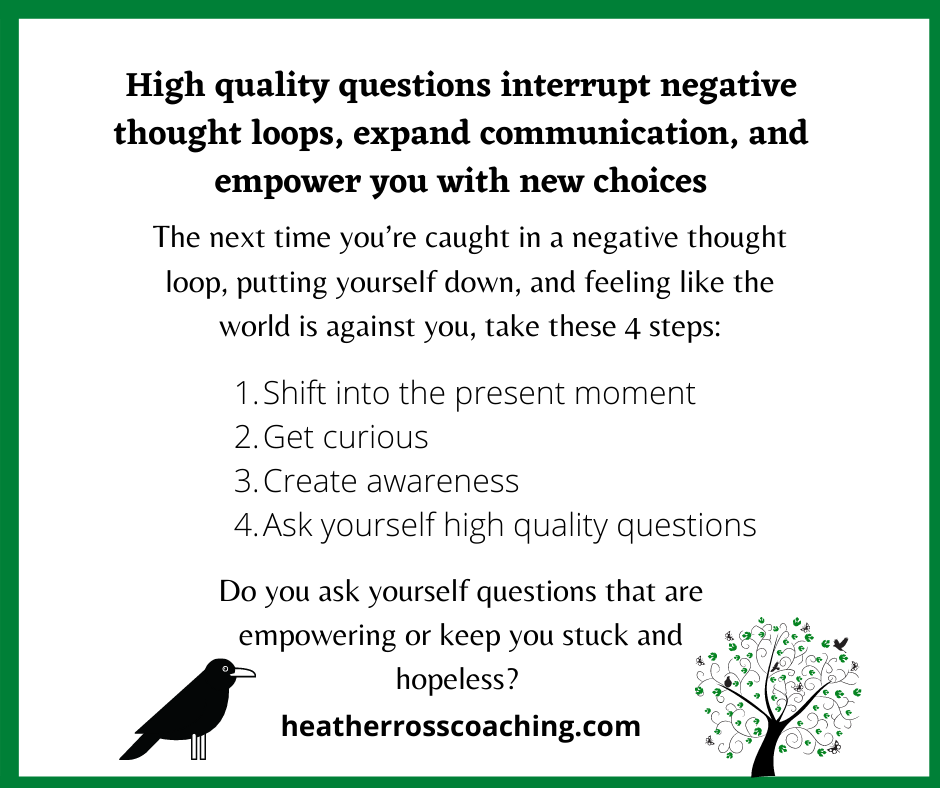Questions are simple yet life changing. I love seeing the lights come on and a coaching client changing in front of my eyes as I ask them questions. The heavy burden of overwhelm lifts, their body relaxes, the brain fog dissipates, clarity kicks in, and they start to see they have more choices than they realized, and choices mean freedom.
When your brain is spinning with autopilot negative thought loops, questions interrupt that loop. Questions engage your prefrontal cortex (PFC) which is the reasoning part of your brain. Negative thought loops happen in our subconscious where our patterns of thoughts and behaviors (wanted and unwanted) live. We want to shift from the subconscious to the PFC to shift our state of being.
Asking yourself quality questions shifts you from auto pilot to in control. When a plane is on autopilot it’s programmed intentionally to get to a specific destination. The problem with the autopilot in our brains is we haven’t programmed it intentionally. Our brain is programmed passively with life experiences. That means our destination isn’t a place we picked. It’s just a place we ended up.
Questions can help you intentionally program your brain to crate the future you want instead of recreating your past. They get you out of your old habits and patterns and into creating a new future.
They are also helpful for communication. Imagine asking your child that’s struggling with addiction quality questions instead of talking at them and telling them what to do. Questions are expansive and open people up. Telling people what to do is restrictive and closes them off. Asking questions also relieves you from the responsibility of having to know all the answers. It gives them the opportunity to figure it out on their own, but with your support.
The next time you’re caught in a negative thought loop, putting yourself down, and feeling like the world is against you, take these 4 steps:
- Shift into the present moment – Thought loops are either based on the past or projections into the future. Take some deep breaths, become aware of your surroundings, and feel into your body.
- Get curious – Shift out of judgement and into curiosity about your thoughts and feelings.
- Create awareness – Try to remember the thoughts you were thinking. We’re often aware of how we feel, but not the thoughts that created the feelings. Knowing our thoughts helps up question them and decide if we want to keep them or cultivate new ones.
- Ask yourself high quality questions – High quality questions empower you and low-quality questions keep you stuck and hopeless. If you ask yourself a low-quality question like “What’s wrong with me?” your brain will give you a list of things that are wrong with you. Thinking about what’s wrong with you will keep you stuck and lead to more negative thought loops. If you ask yourself a high-quality question like “What could I do different next time?” your brain searches for solutions and you get to choose which answers are freeing.
What type of questions have you been asking yourself?
Here are some more examples of high-quality questions:
- What’s best for me in this situation?
- What do I want to believe about myself, the situation, or other person?
- What is my motivation for telling someone what to do?
- What can I do different next time?
- What did I do right?
- What can I do to support myself right now?
- Is the energy I’m giving to this situation serving me?
- Am I truly responsible for this?
- Can I see this situation from a different perspective?
- What would love do?
- Am I being guided by fear?
- Do I think this thought a lot? Why is that? How can I change it?
- Would I offer more compassion and grace for someone else in my situation than I offer myself?
- What are some thoughts I can think on purpose the next time this happens?



